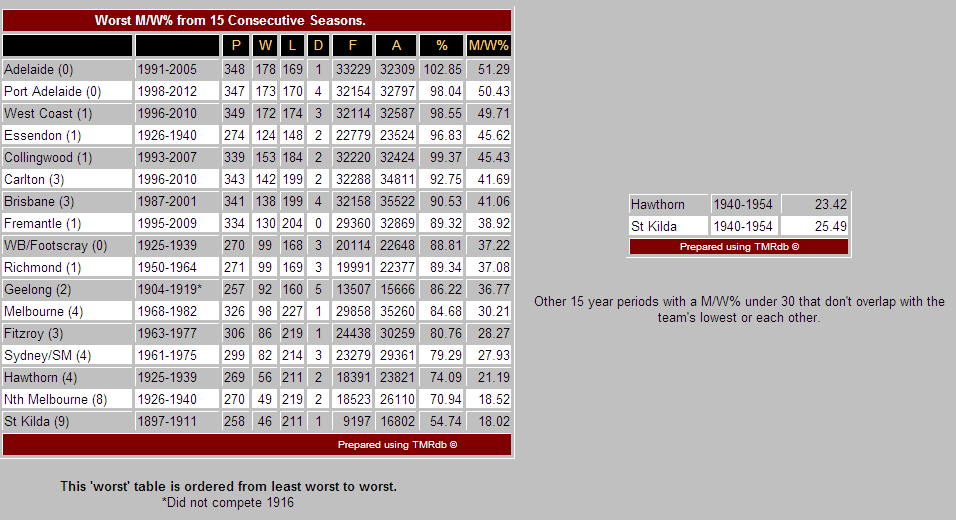- Dec 17, 2006
- 4,400
- 4,669
- AFL Club
- Collingwood

- Other Teams
- South Fremantle, Sturt
Some teams take longer to attain their first premiership than others. For example, the West Coast Eagles and Adelaide Crows took just 5 & 6 years respectively to win their first flags, while North Melbourne took 50 and St Kilda an astonishing 69 years (with no flags in 45 years since).
But which teams in various leagues are still waiting for their chance at premiership glory?
In the AFL, Fremantle has not seriously challenged for a premiership in 17 completed seasons since their entry to the league in 1995.
Coincidentally, the two remaining NRL teams admitted in 1995, the North Queensland Cowboys and New Zealand Warriors (Perth Reds and South Queensland Crushers left the competition years ago) are also awaiting their maiden premierships, although unlike the Dockers these two have played in Grand Finals. However, their friends the Cronulla Sharks have not won a premiership since joining the league in 1967 - 45 years!
The WAFL, consisting of 9 clubs, somewhat resembles the Solar System, and the newest club, Peel Thunder, is the equivalent of Pluto. Since commencing in 1997, the Thunder have not even remotely challenged for a finals spot, let alone a premiership.
The SANFL does not have a club without a premiership, with no new clubs admitted since the Woodville-West Torrens merger after the 1990 season.
The VFA/VFL is harder to gauge given the relative instability of this competetion, but Frankston's only premiership was achieved in second division way back in 1978. It has not won a first division premiership since its admission in 1965, remarkable because it has always had a large area with a big population to itself throughout the Dolphins' time in the VFA/L. The Bendigo Bombers, and their predecessors the Bendigo Diggers, have also failed to land a premiership in 14 years.
The Western Jets played in the first two TAC grand finals in 1992-93 without winning one and are still awaiting redemption. The Dandenong Southern Stingrays have made an artform of losing grand finals since their inception in 1992, while the Bendigo Pioneers are also yet to win a flag since commencing in 1993.
This covers the major leagues - can anyone name teams from other smaller leagues around Australia still awaiting their first premiership?
But which teams in various leagues are still waiting for their chance at premiership glory?
In the AFL, Fremantle has not seriously challenged for a premiership in 17 completed seasons since their entry to the league in 1995.
Coincidentally, the two remaining NRL teams admitted in 1995, the North Queensland Cowboys and New Zealand Warriors (Perth Reds and South Queensland Crushers left the competition years ago) are also awaiting their maiden premierships, although unlike the Dockers these two have played in Grand Finals. However, their friends the Cronulla Sharks have not won a premiership since joining the league in 1967 - 45 years!
The WAFL, consisting of 9 clubs, somewhat resembles the Solar System, and the newest club, Peel Thunder, is the equivalent of Pluto. Since commencing in 1997, the Thunder have not even remotely challenged for a finals spot, let alone a premiership.
The SANFL does not have a club without a premiership, with no new clubs admitted since the Woodville-West Torrens merger after the 1990 season.
The VFA/VFL is harder to gauge given the relative instability of this competetion, but Frankston's only premiership was achieved in second division way back in 1978. It has not won a first division premiership since its admission in 1965, remarkable because it has always had a large area with a big population to itself throughout the Dolphins' time in the VFA/L. The Bendigo Bombers, and their predecessors the Bendigo Diggers, have also failed to land a premiership in 14 years.
The Western Jets played in the first two TAC grand finals in 1992-93 without winning one and are still awaiting redemption. The Dandenong Southern Stingrays have made an artform of losing grand finals since their inception in 1992, while the Bendigo Pioneers are also yet to win a flag since commencing in 1993.
This covers the major leagues - can anyone name teams from other smaller leagues around Australia still awaiting their first premiership?





